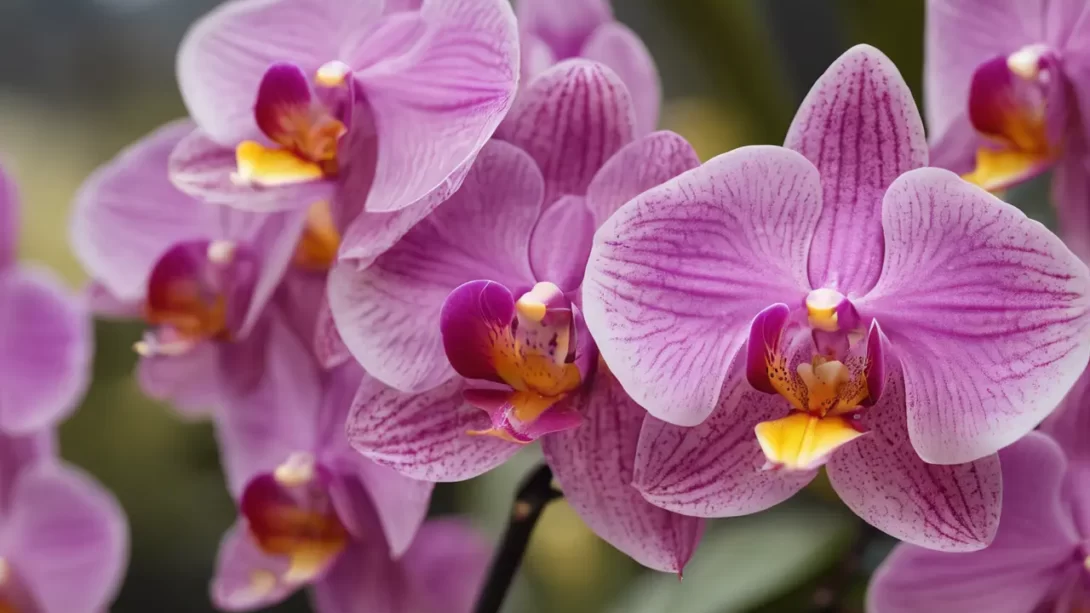Orchids are renowned for their elegant beauty and diverse species, making them a favorite among houseplant enthusiasts. However, growing orchids can sometimes be challenging, especially when unexpected issues like a yellowing stem arise. Understanding why an orchid’s stem turns yellow is crucial for maintaining the health and vibrancy of these delicate plants. This article explores the various factors contributing to this common problem and provides insights into orchid care.
Orchid Anatomy
Description of Orchid Parts: Stem, Leaves, Roots, and Flowers
Orchids are unique in their structure, consisting of several key parts: the stem, leaves, roots, and flowers. The stem, particularly in sympodial orchids, acts as the plant’s backbone, supporting leaves and flowers. It is vital for the transport of nutrients and water throughout the plant.
Role of the Stem in Orchid Health and Growth
The health of an orchid’s stem is often a direct indicator of the overall well-being of the plant. A healthy orchid stem should be firm and a vibrant green color. It plays a pivotal role in supporting the orchid’s leaves and blooms while ensuring the proper distribution of nutrients and water.
Normal vs. Abnormal Color Changes in Orchid Stems
While some color changes in orchid stems are normal, especially during different growth phases or flowering periods, yellowing is typically a sign of stress or poor health. Understanding the distinction between natural and concerning color changes is essential for effective orchid care.
Common Causes of Stem Yellowing in Orchids
Insufficient Watering
One of the primary causes of yellowing stems in orchids is improper watering. Both under-watering and over-watering can lead to stress, manifesting as a yellow discoloration in the stem.
Effects of Under-Watering and Over-Watering
Under-watered orchids can exhibit yellow stems due to dehydration and nutrient deficiencies. Conversely, over-watering can lead to root rot, which hinders the plant’s ability to absorb water and nutrients, causing the stem to turn yellow.
How Improper Watering Leads to Stress and Discoloration in Stems
The balance of watering is critical. Orchids need a well-draining medium and should not sit in waterlogged soil. The frequency of watering varies depending on factors like the type of orchid, the growing medium, and environmental conditions. Recognizing the signs of water stress is key to preventing and addressing yellowing stems.
Nutrient Deficiencies or Imbalances
Nutrients play a vital role in the health and coloration of orchid stems. A deficiency or imbalance can lead to yellowing stems, signaling that the plant is not receiving the essential nutrients it needs.
Role of Nutrients in Orchid Health
Orchids require a balanced supply of nutrients, including nitrogen, potassium, phosphorus, and trace elements. These nutrients support various physiological processes, from growth to flowering.
Specific Deficiencies Leading to Yellowing
Nitrogen deficiency, for example, can cause the stem and leaves to turn yellow as the plant redirects limited nitrogen to new growth. Similarly, a lack of magnesium, which is critical for chlorophyll production, can lead to yellowing.
Lighting Issues
Proper lighting is crucial for orchid health. Both insufficient and excessive light can stress the plant, leading to a yellow stem.
Impact of Too Much or Too Little Light
Orchids receiving too little light may develop pale, yellow stems as they struggle to photosynthesize. On the other hand, too much direct sunlight can scorch the stem and leaves, causing them to turn yellow or brown.
Finding the Right Balance for Optimal Orchid Health
Determining the right amount and intensity of light is essential. Most orchids thrive in bright, indirect light. Adjusting the plant’s location or using sheer curtains to filter direct sunlight can help achieve the ideal lighting conditions.
Temperature Stress
Orchids are sensitive to temperature changes, and extreme fluctuations can cause stem yellowing.
Effects of Temperature Fluctuations on Orchids
Sudden changes in temperature, especially cold drafts or excessive heat, can stress orchids. This stress can manifest as yellowing in the stem, indicating that the plant is not in its optimal growing environment.
Ideal Temperature Range for Orchids to Thrive
Most orchids prefer a consistent temperature range, typically between 60 and 80 degrees Fahrenheit (15 and 27 degrees Celsius). Keeping orchids away from sources of direct heat or cold drafts, and maintaining a stable environment, is key to preventing temperature-induced stress.
Disease and Pest Infestations
Orchids can be susceptible to various diseases and pests, which can contribute to stem yellowing. Understanding and identifying these threats is crucial for the health of the plant.
Common Diseases and Pests Affecting Orchids
Fungal and bacterial infections can cause yellowing and decay in orchid stems. Pests like aphids, spider mites, and scale insects can also stress the plant, leading to discoloration.
How Diseases and Pests Manifest as Yellowing Stems
Infections often result in yellow spots or streaks on the stem, which can spread if untreated. Pest infestations might cause the stem to weaken and turn yellow due to the damage they inflict and the stress they cause to the plant.
Diagnostic Tips
Determining the exact cause of yellowing in orchid stems requires careful observation. Check for signs of over or under-watering, assess light and temperature conditions, and inspect for signs of diseases or pests. The presence of root rot, leaf discoloration, or visible pests can provide clues to the underlying issue.
Remedial Measures
Appropriate Watering Techniques for Orchids
Ensure a proper watering schedule, allowing the growing medium to dry slightly between waterings. Use tepid water and avoid letting the orchid sit in water.
Adjusting Light, Temperature, and Feeding for Optimal Health
Position your orchid in bright, indirect light and maintain a consistent, suitable temperature. Feed your orchid with a balanced fertilizer formulated for orchids, following package instructions to avoid over-fertilization.
Treating Diseases and Pests Specific to Orchids
For diseases, remove affected parts and apply appropriate fungicides or bactericides. For pests, use insecticidal soaps or horticultural oils, ensuring to follow application guidelines.
Preventative Care
Prevention is key to avoiding yellowing stems in orchids. Regularly monitor your orchid’s environment, adjusting water, light, and temperature as needed. Keep an eye out for early signs of disease or pests and address them promptly. A consistent care routine is essential for keeping your orchid healthy.
Conclusion
Yellowing stems in orchids can be a sign of various issues, from environmental stressors to diseases and pests. By understanding the causes and implementing the right care techniques, you can restore and maintain the health of your orchid. Regular observation and prompt action are crucial in ensuring that your orchid continues to thrive and bring beauty to your space.




